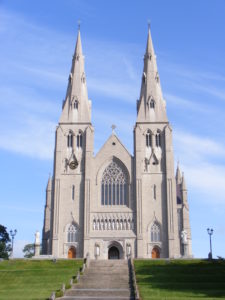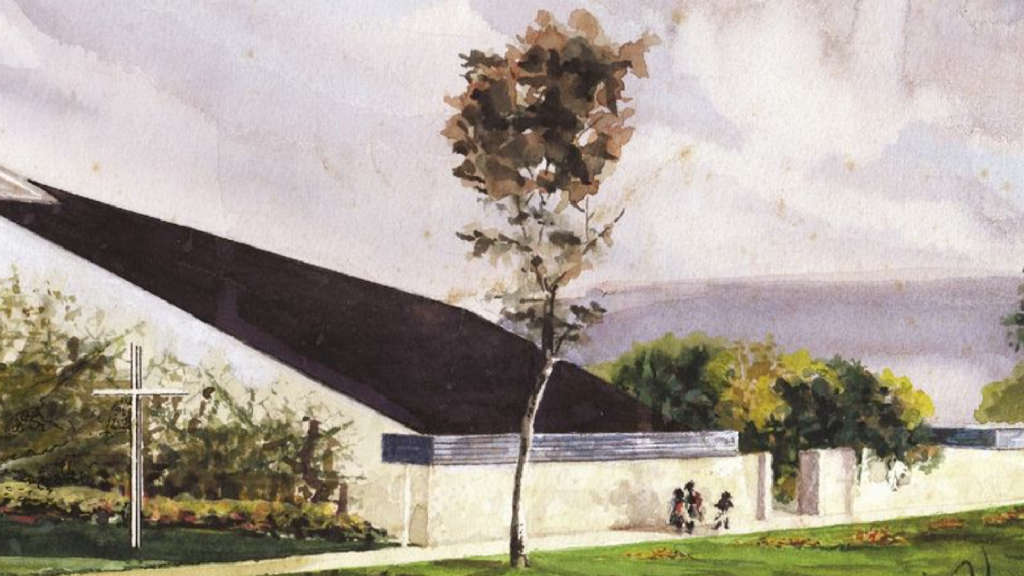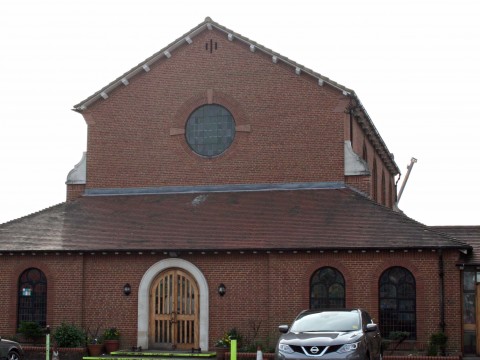Churches of the Day
Pictorial Thought for Today

Dec 18 - St Flannan (7th century)
 St Flannan is the patron saint of the diocese of Killaloe. This diocese includes large portions of the counties of Clare and North Tipperary; it also includes smaller portions of Offaly, Laois, and Limerick. The diocesan cathedral of Saints Peter and Paul is at Ennis. Portraits of Saints Flannan and Senan accompany those of Sts Peter and Paul in the sanctuary.
St Flannan is the patron saint of the diocese of Killaloe. This diocese includes large portions of the counties of Clare and North Tipperary; it also includes smaller portions of Offaly, Laois, and Limerick. The diocesan cathedral of Saints Peter and Paul is at Ennis. Portraits of Saints Flannan and Senan accompany those of Sts Peter and Paul in the sanctuary.Patrick Duffy summarises some traditions about the saint's life.
St Molua (554-609)
St Molua was reputed to have been the first abbot and founder of Killaloe. He was born in Ardagh, Co Limerick, where the parish church is called after him. On a visit to Munster, St Comhghall, Abbot of Bangor, found him asleep in a field where he was tending his father's flocks and recognising the boy's holiness, took him with him to Bangor. There he studied for the religious life and was ordained a priest. Molua is said to have founded monasteries at his home place Ardagh in Co Limerick, at Killaloe, at Friars' Island near Ardnacrusha (covered in 1930 by the damming for the hydroelectric scheme), at Cluain Fearta Molua (Kyle, north of Borris-in-Ossory Co Laois) on the Leinster/Munster border near his mother's home. There is also a Church of St Molua (Church of Ireland) in the Stormont area of east Belfast.
St Flannan succeeds St Molua at Killaloe
 St Flannan is said to have been the son of Turlough, King of Thomond, and also Molua's nephew and first disciple. There is a story that one day, after he had been baking continously for thirty-six hours, a heavenly light shone through the fingers of his left hand. It lit up the darkness to enable him to continue with his task. Molua, on learning of this, decided to retire from his position and appointed Flannan as abbot in his place. The image (above)shows St. Flannan's Cathedral, Killaloe.
St Flannan is said to have been the son of Turlough, King of Thomond, and also Molua's nephew and first disciple. There is a story that one day, after he had been baking continously for thirty-six hours, a heavenly light shone through the fingers of his left hand. It lit up the darkness to enable him to continue with his task. Molua, on learning of this, decided to retire from his position and appointed Flannan as abbot in his place. The image (above)shows St. Flannan's Cathedral, Killaloe.Travels to Rome and Scotland?
Flannan was noted for his hospitality and the people of Thomond agreed he should become bishop. He is said to have made a trip to Rome where he received consecration from Pope John IV (640-2). There were churches dedicated to him at Inishlannaun in Lough Corrib and another on Inishbofin. The Flannan Islands in the Outer Hebrides may be connected to his cult. However, it is not certain that the Scottish Flannan is the same as the Killaloe Flannan. There is a possibility that there was a second saint called Flannan.
Propaganda?
Former diocesan historian, Fr Ignatius Murphy (died 1993), referring to the abundance of legends about St Flannan, dismissed the medieval life as historically valueless and said we have very little hard information about him. Murphy maintained that Flannan lived in the 8th century, possibly in West Clare, and that the prominence given to him was due to family pride and propaganda on the part of the kings of the Dal gCais in the 11th and 12th centuries.
Patron of Killaloe Diocese
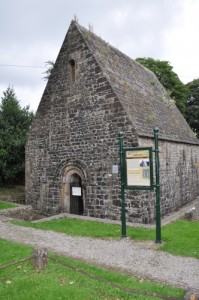
However that may be, St Flannan emerged as the patron of the diocese of Killaloe. The Church of Ireland Cathedral in Killaloe is called after him as is the diocesan college, St Flannan's, Ennis.
When the diocese was established at the Synod of Rathbreasail in 1111, it was made up of three separate dioceses which had been founded around three abbeys: Killaloe, under Saints Molua and Flannan; Roscrea, founded by St Crónán (d. 665); and Scattery Island (Inis Cathaigh), founded by St Senan.
Other monks venerated locally as saints include:
St Brendan of Birr,
St Caimin of Inis Cealtra in Lough Derg and
St Ruadhán of Lorrha, Co Tipperary, near Portumna.
____________________________________
******************************
Memorable Saying for Today
If we are faithful to God in little things,
we shall gain experience and strength that will be helpful
to us in the more serious trials of life.
~ Hudson Taylor ~
******************************
The Advent Octave before Christmas: Thursday, Day 2 : -18th December. (O Adonai)
St Matthew stresses the Divinity of Christ and Joseph, to be a man of integrity
Saint of the Day: Dec 18th : St Flannan, monk in Killaloloe, abbot, bishop
C/f A short history of today’s saint, can be found below today’s Readings and Reflection.
FIRST READING
A reading from the prophet Jeremiah 23: 5-8
I will raise a virtuous Branch for David.
'See, the days are coming - it is the Lord who speaks –when I will raise a virtuous Branch for David,

who will reign as true king and be wise, practising honesty and integrity in the land.
In his days Judah will be saved and Israel dwell in confidence.
And this is the name he will be called: the Lord-our-Integrity.
'So, then, the days are coming - it is the Lord who speaks –
when people will no longer say, "As the Lord lives who brought the sons of Israel out of the land of Egypt!" but, "As the Lord lives who led back and brought home the descendants of the House of Israel out of the land of the North
and from all the countries to which he had dispersed them, to live on their own soil." '
The Word of the Lord Thanks be to God
Responsorial Psalm Ps: 71: 1-2, 12-13, 18-19, R/v 7
Response In his days justice shall flourish and peace till the moon fails.
1. O God, give your judgement to the king, to a king's son your justice,
that he may judge your people in justice and your poor in right judgement. Response
2. For he shall save the poor when they cry and the needy who are helpless.
He will have pity on the weak and save the lives of the poor. Response
3. Blessed be the Lord, God of Israel, who alone works wonders,
ever blessed his glorious name. Let his glory fill the earth. Amen! Amen! Response
Gospel Acclamation
Alleluia, alleluia!
O Ruler of the House of Israel who gave the law to Moses on Sinai,
come and save us with outstretched arm.
Alleluia!
GOSPEL
The Lord be with you. And with your spirit
A reading from the holy Gospel according to Matthew 1:18-24 Glory to you, O Lord.
Jesus is born of Mary who was betrothed to Joseph, son of David.
 This is how Jesus Christ came to be born. His mother Mary was betrothed to Joseph; but before they came to live together she was found
This is how Jesus Christ came to be born. His mother Mary was betrothed to Joseph; but before they came to live together she was foundto be with child through the Holy Spirit. Her husband Joseph; being a man of honour and wanting to spare her publicity, decided to divorce her informally.
He had made up his mind to do this when the angel of the Lord appeared to him in a dream and said,
'Joseph son of David, do not be afraid to take Mary home as your wife, because she has conceived
what is in her by the Holy Spirit. She will give birth to a son and you must name him Jesus,
because he is the one who is to save his people from their sins.'
Now all this took place to fulfil the words spoken by the Lord through the prophet:
The virgin will conceive and give birth to a son and they will call him 'Emmanuel',
a name which means 'God-is-with-us.'
When Joseph woke up he did what the angel of the Lord had told him to do: he took his wife to his home.
The Gospel of the Lord Praise to you, Lord Jesus Christ.
**************************
Gospel Reflection 18 Dec, Day 2 Pre-Christmas Octave Matthew 1:18–24
Today’s gospel reading gives us Matthew’s account of the birth of Jesus. Luke’s account of Jesus’ birth has so caught the imagination of artists and storytellers down the centuries that Matthew’s account has found itself in the shade somewhat. In Luke’s account of Jesus’ birth, Mary is more to the fore than Joseph. In Matthew’s account it is Joseph who is to the fore. In our gospel reading the annunciation of Jesus’ birth is made to Joseph, not to Mary. He needs reassuring when he discovers that Mary his betrothed is pregnant before they have come to live together as husband and wife. Out of consideration for Mary, he had initially decided to divorce her informally, until the angel Gabriel announced to him the true nature of Mary’s pregnancy, ‘She has conceived what is in her by the Holy Spirit’, and the true significance of the child in her womb, ‘She will give birth to a son and you must name him Jesus, because he is the one who is to save his people from their sins’.
Apart from the name Jesus, the name ‘Emmanuel’, found in the prophet Isaiah, will also apply to him, ‘God-with-us’. Mary’s child will be the presence of the merciful God among us. In response to that annunciation, that revelation, Joseph took Mary home as his wife. The gospel reading gives us a picture of Joseph struggling to discern what God is asking of him in a situation he doesn’t fully understand. We are all like Joseph in that regard. We make a decision, thinking it is God’s will for our lives, and then we have to review it as it becomes clear to us that, perhaps, this is not what God is asking of us. We are always trying to discern God’s call, what God is asking of us in the here and now. As a man who had much to discern, Saint Joseph can be a very good companion for us in those complex moments in our own lives when there is much to be discerned.
________________________________
The Scripture Readings are taken from The Jerusalem Bible, published 1966 by Darton, Longman and Todd Ltd and used with the permission of the publishers. http://dltbooks.com/
The Scripture Reflection is made available with our thanks from Fr Martin Hogan's book Reflections on the Weekday Readings : The Word is Near to You, on your lips and in your heart published by Messenger Publications c/f www.messenger.ie/bookshop/
__________________________
Saints of the day: Dec 18th, St Flannan, monk, bishop, preacher. ( 554-609A.D.)
Flannan lived in the seventh century and was the son of a king of Thomond. He entered St Molua's monastery at Killaloe and became abbot there.
He is remembered as a powerful preacher.

Patrick Duffy summarises some traditions about the St Flannan's life.
Flannan is the patron saint of the diocese of Killaloe, Ireland. This diocese includes large portions of the counties of Clare and North Tipperary; it also includes smaller portions of Offaly, Laois, and Limerick. The diocesan cathedral of Saints Peter and Paul is at Ennis. Portraits of Saints Flannan and Senan accompany those of Ss Peter and Paul in the sanctuary. He was often referred to as 'the great preacher.'
St Flannan
Flannan was reputed to have been the first abbot and founder of Killaloe. He was born in Ardagh, Co Limerick, where the parish church is called after him. On a visit to Munster, St Comhghall, Abbot of Bangor, found him asleep in a field where he was tending his father's flocks and recognising the boy's holiness, took him with him to Bangor. There he studied for the religious life and was ordained a priest. He is said to have founded monasteries at his home place Ardagh in Co Limerick, at Killaloe, at Friars' Island near Ardnacrusha (covered in 1930 by the damming for the hydroelectric scheme), at Cluain Fearta Molua (Kyle, north of Borris-in-Ossory Co Laois) on the Leinster/Munster border near his mother's home. There is also a Church of St Molua (Church of Ireland) in the Stormont area of east Belfast.
St Flannan succeeds St Molua at Killaloe
 St Flannan is said to have been the son of Turlough, King of Thomond, and also Molua's nephew and first disciple. There is a story that one day, after he had been baking continously for thirty-six hours, a heavenly light shone through the fingers of his left hand. It lit up the darkness to enable him to continue with his task. Molua, on learning of this, decided to retire from his position and appointed Flannan as abbot in his place. The image (right)shows St. Flannan's Cathedral, Killaloe.
St Flannan is said to have been the son of Turlough, King of Thomond, and also Molua's nephew and first disciple. There is a story that one day, after he had been baking continously for thirty-six hours, a heavenly light shone through the fingers of his left hand. It lit up the darkness to enable him to continue with his task. Molua, on learning of this, decided to retire from his position and appointed Flannan as abbot in his place. The image (right)shows St. Flannan's Cathedral, Killaloe.Travels to Rome and Scotland?
Flannan was noted for his hospitality and the people of Thomond agreed he should become bishop. He is said to have made a trip to Rome where he received consecration from Pope John IV (640-2). There were churches dedicated to him at Inishlannaun in Lough Corrib and another on Inishbofin. The Flannan Islands in the Outer Hebrides may be connected to his cult. However, it is not certain that the Scottish Flannan is the same as the Killaloe Flannan. There is a possibility that there was a second saint called Flannan.
Propaganda?
Former diocesan historian, Fr Ignatius Murphy (died 1993), referring to the abundance of legends about St Flannan, dismissed the medieval life as historically valueless and said we have very little hard information about him. Murphy maintained that Flannan lived in the 8th century, possibly in West Clare, and that the prominence given to him was due to family pride and propaganda on the part of the kings of the Dal gCais in the 11th and 12th centuries.
Patron of Killaloe Diocese
[caption id="attachment_73517" align="alignleft" width="156"]
 Killaloe Historic Town Trail.[/caption]
Killaloe Historic Town Trail.[/caption]However that may be, St Flannan emerged as the patron of the diocese of Killaloe. The Church of Ireland Cathedral in Killaloe is called after him as is the diocesan college, St Flannan's, Ennis.
When the diocese was established at the Synod of Rathbreasail in 1111, it was made up of three separate dioceses which had been founded around three abbeys: Killaloe, under Saints Molua and Flannan; Roscrea, founded by St Crónán (d. 665); and Scattery Island (Inis Cathaigh), founded by St Senan.
Other monks venerated locally as saints include:
St Brendan of Birr,
St Caimin of Inis Cealtra in Lough Derg and
St Ruadhán of Lorrha, Co Tipperary, near Portumna.
******************************
Memorable Saying for Today
If we are faithful to God in little things,
we shall gain experience and strength that will be helpful to us in the more serious trials of life.
~ Hudson Taylor ~
******************************
CÉAD LÉACHT
Sliocht as an fáidh Irimia 23: 5-8
Ardóidh mé do Dháiví beangán fíréanta
Feach, tá na laethanta ag teacht – an Tiarna a labhraíonn –

agus ardóidh mé do Dháiví beangán fíréanta;
rialóidh sé ina rí go críonna, agus déanfaidh sé breithiúnas agus ceart sa talamh.
Ina laethanta siúd sábhálfar Iúdá agus cónóidh Iosrael faoi dhóchas.
Is é seo an t-ainm a bhéarfar air: An Tiarna ár bhfíréantacht.
“Mar sin, tá na laethanta ag teacht – an Tiarna a labhraíonn –
nach ndéarfaidh daoine níos mó: ‘Go maire an Tiarna a thug clann Iosrael as críoch na hÉigipte!’ ach: ‘Go maire an Tiarna a thug ar ais agus a threoraigh abhaile sliocht theach Iosrael as an tír thuaidh agus as gach uile thír inar dhíbir sé iad, le go ndéanfaidís cónaí ina dtír féin.’”
Briathar an Tiarna Buíochas le Dia
Salm le Freagra Sm 71: 1-2, 12-13, 18-19, R/v 7
Freagra Bláthóidh síochcáin agus fíréantacht lena linn nó go meathfaidh an ghealach.
 1. Tabhair do bhreithiúnas, a Dhia, don rí agus d'fíréantacht do mhac an rí.
1. Tabhair do bhreithiúnas, a Dhia, don rí agus d'fíréantacht do mhac an rí.Go dtuga se ceartbhreithiúnas ar a phobal agus cothrom do na bochtáin. Freagra
2. Saorfaidh se na bochtáin nuair a ghlaofaidh siad air agus na hainniseoiri gan chunamh.
Glacfaidh se trua don duine lag agus sabhalfaidh se an duine dealbh. Freagra
3. Moladh leis an Tiarna, Dia Isráél, an tAon amhain a dheanann éachtaí
Moladh go deo lena ainm glórmhar. Go Iíona a ghlóir an talamh. Amen! Amen! Freagra
SOISCÉAL
Go raibh an Tiarna libh. Agus le do spiorad féin
Sliocht as an Soiscéal naofa de réir Matha 1:18-24 Glóir duit, a Thiarna.
Beidh an mhaighdean torrach agus béarfaidh sí mac agus tabharfar Imeánuéil mar ainm air.
Seo mar a tharla Íosa Críost a shaolú. Bhí Muire, a mháthair, luaite le Iósaef, agus
sula ndearnadar aontíos, fuarthas torrach í ón Spiorad Naomh. Ba dhuine cóir a fear
céile Iósaef, ach níorbh áil leis go dtabharfaí míchlú di, agus chinn sé í a scaoileadh uaidh
 os íseal. Ag machnamh ar an méid sin dó, áfach, thaispeáin aingeal ón Tiarna é féin dó i mbrionglóid agus dúirt:
os íseal. Ag machnamh ar an méid sin dó, áfach, thaispeáin aingeal ón Tiarna é féin dó i mbrionglóid agus dúirt:“A Iósaef, a mhic Dháiví, ná bíodh eagla ort do bhean chéile
Muire a thabhairt abhaile leat, óir, an leanbh atá gafa aici, is ón Spiorad Naomh é.
Béarfaidh sí mac, agus tabharfaidh tú Íosa mar ainm air, óir slánóidh sé a phobal óna bpeacaí.”
Thit an méid sin go léir amach chun go gcomhlíonfaí a ndúirt an Tiarna tríd an bhfáidh:
“Beidh an mhaighdean torrach agus béarfaidh sí mac agus tabharfar Imeánuéil mar ainm air,” – ainm a chiallaíonn: Tá Dia linn.
Dhúisigh Iósaef agus d’éirigh, agus rinne mar d’ordaigh aingeal an Tiarna dó: a bhean a thabhairt abhaile leis.
Soiscéal an Tiarna. Moladh duit, a Chriost
AN BÍOBLA NAOFA
© An Sagart
- 21-12-2025 -
Fourth Sunday of Advent - O Oriens

Our attention this final Week of Advent is directed fully to the coming of Christ in the Christmas mystery.
The Preface calls us to wonder at this great happening, to prepare for Christmas in prayer and praise.
he psalm tells us to purify our hearts, prayer and reconciliation are the tools for these days.
FIRST READING
A reading from the book of the Prophet Isaiah 7:10-14
The maiden is with child.
The Lord spoke to Ahaz and said,
'Ask the Lord your God for a sign for yourself coming either from the depths of Sheol or from the heights above'.

'No,' Ahaz answered 'I will not put the Lord to the test.'
Then Isaiah said:
Listen now, House of David: are you not satisfied with trying the patience of men
without trying the patience of my God, too?
The Lord himself, therefore, will give you a sign.
It is this: the maiden is with child and will soon give birth to a son whom she will call 'Emmanuel, ' a name which means “God is with us.”
The Word of the Lord Thanks be to God.
Responsorial Psalm Ps 23:1-6 R/v. 7. 10
Response Let the Lord enter! He is the king of glory.
1. The Lord's is the earth and its fullness, the world and all its peoples.
It is he who set it on the seas; on the waters he made it firm. Response
2. Who shall climb the mountain of the Lord? Who shall stand in his holy place?
The man with clean hands and pure heart, who desires not worthless things. Response
3. He shall receive blessings from the Lord and reward from the God who saves him.
Such are the men who seek him, seek the face of the God of Jacob. Response
SECOND READING
A reading from the letter of St Paul to the Romans 1:1-7
Jesus Christ, descendant of David, Son of God.
From Paul, a servant of Christ Jesus who has been called to be an apostle, and specially chosen to preach the Good News that God promised long ago through his prophets in the scriptures.
This news is about the Son of God who, according to the human nature he took was a descendant
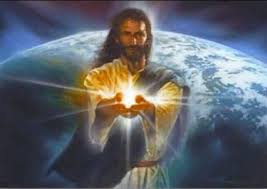 of David:
of David:it is about Jesus Christ our Lord who, in the order of the spirit, the spirit of holiness that was in him, was proclaimed Son of God in all his power through his resurrection from the dead.
Through him we received grace and our apostolic mission to preach the obedience of faith to all pagan nations in honour of his name. You are one of these nations, and by his call belong to Jesus Christ.
To you all, then, who are God's beloved in Rome, called to be saints, may God our Father and the Lord Jesus Christ send grace and peace.
The Word of the Lord Thanks be to God.
Gospel Acclamation Mt 1:23
Alleluia, alleluia!
'The virgin will conceive and give birth to a son and they will call him
Emmanuel, a name which means 'God-is-with-us'.
Alleluia
The Lord be with you And with your spirit.
A reading from the Gospel according to Matthew 1:18-24 Glory to you, O Lord
Jesus is born of Mary who was betrothed to Joseph, son of David.
This is how Jesus Christ came to be born. His mother Mary was betrothed to Joseph; but before they came to live together she was found to be with child through the Holy Spirit. Her husband Joseph; being a man of honour and wanting to spare her publicity, decided to divorce her informally. He had made up his mind to do this when the angel of the Lord appeared to him in a dream and said,

'Joseph son of David, do not be afraid to take Mary home as your wife, because she has conceived what is in her by the Holy Spirit. She will give birth to a son and you must name him Jesus, because he is the one who is to save his people from their sins.'
Now all this took place to fulfil the words spoken by the Lord through the prophet:
'The virgin will conceive and give birth to a son and they will call him 'Emmanuel,' a name which means 'God-is-with-us'.
When Joseph woke up he did what the angel of the Lord had told him to do: he took his wife to his home.
The Gospel of the Lord Praise to you, Lord Jesus Christ.
*********************
For homily resources for this Sunday's Gospel click here: https://www.catholicireland.net/sunday-homily/
Taken from THE JERUSALEM BIBLE, published and copyright 1966, by Darton, Longman and Todd Ltd and Doubleday, a division of Random House Inc, and used by permission of the publishers.
-21-12- 2025-
AN CEATHRÚ DOMNACH DEN AIDBHINT, Blian A
CÉAD LÉACHT
Sliocht as an Leabhar Íseáia 7:10-14
Ta an óghbhean ag iompar.
Labhair an Tiarna le hÁchaz arís agus dúirt: “Iarr comhartha duit féin ar an Tiarna do Dhia, as duibheagáin Sheól aníos nó thuas in arda na spéartha.”
D’fhreagair Áchaz: “Ní iarrfaidh, níl mé chun dúshlán an Tiarna a thabhairt.”
Ansin dúirt sé:
 “Éistigí mar sin, a theaghlach Dháiví, an é nach beag daoibh sárú ar dhaoine
“Éistigí mar sin, a theaghlach Dháiví, an é nach beag daoibh sárú ar dhaoinego gcaithfidh sibh mo Dhia a shárú ina theannta sin?
Is é an Tiarna féin mar sin a thabharfaidh comhartha daoibh.
Seo, tá an ógbhean ag iompar agus ar tí mac a shaolú,
agus tabharfaidh sí Ímeánuéil mar ainm air. is é sin, “Tá Dia-linn.
Briathar an Tiarna Buíochas le Dia
Salm le Freagra Sm 23:1-6 R/v. 7. 10
Freagra Tagadh an Tiarna isteach! Is e Rí na glóire é.
I. Leis an Tiarna an chruinne agus a bhfuil inti: an domhan go léir agus a maireann ann.
Is é féin a bhunaigh ar an aigéan é, agus a dhaingnigh ar an bhfarraige íochtarach é. Freagra
2. Cé a rachaidh suas ar chnoc an Tiarna? Cé a bheidh ina sheasamh ar a láthair naofa?
An té a bhfuil lámha gan smál agus croí glan aige, an té ar beag air nithe gan tairbhe. Freagra
3. Beidh beannacht an Tiarna ar an té sin agus luach saothair ó Dhia a shlánaitheoir.
A leithéid siúd a bhíonn á lorg, a bhíonn ar thóir Dhia Iácób. Freagra
DARA LÉACHT
Sliocht as Litir Naomh Pól chuig na Rómhánaigh 1:1-7
Íosa Críost, de shliocht Dháivi, Mac Dé.
Mise Pól, searbhónta Íosa Críost, a bhfuil glaoite air chun bheith ina aspal atá dealaithe amach chun dea-scéal Dé. An dea-scéal seo, a gheall Dia roimh ré trína chuid fáithe sna scríbhinní naofa,

is faoina Mhac féin é, ár dTiarna Íosa Críost. Rugadh eisean sa mhéid gur duine é de shliocht Dháiví: ach sa mhéid gur spiorad na naofachta é tá sé oirnithe i gcumhacht mar Mhac do Dhia ó aiséirí dó ó mhairbh. Is trídsean a fuair mise grásta an aspail chun géillsine an chreidimh a leathadh ar son a ainm i measc na náisiún uile. Orthusan chomh maith tá sibhse a bhfuil glaoite oraibh chun bheith ina sheilbh ag Íosa Críost. Chugaibhse go léir sa Róimh, más ea, a bhfuil grá ag Dia daoibh agus a bhfuil glaoite oraibh chun bheith in bhur bpobal naofa aige, guím grásta agus síocháin ó Dhia ár nAthair agus ón TiarnaÍosa Críost.
Briathar an Tiarna Buíochas le Dia.
Alleluia! Mth 1:23
Alleluia, alleluia!
Beidh an mhaighdean torrach agus béarfaidh si mac agus bhéarfar
Emmanúél mar ainm air -ainm a chiallaionn 'Tá-Dia-linn'.
Alleluia!
SOISCÉAL
Go raibh an Tiarna libh. Agus le do spiorad féin
Sliocht as Soiscéal naofa de réir Naomh Mhatha 1:18-24 Glóir duit a Thiarna.
Seasfaidh flaitheas Dháivi go daingean i la’thair an Tiarna.
Seo mar a tharla Íosa Críost a shaolú.
Bhí Muire, a mháthair, luaite le Iósaef, agus sula ndearnadar aontíos, fuarthas torrach í ón Spiorad Naomh. Dhuine cóir a fear céile Iósaef, ach níorbh áil leis go dtabharfaí míchlú di, agus chinn sé í a scaoileadh uaidh os íseal. Ag machnamh ar an méid sin dó, áfach, thaispeáin aingeal ón Tiarna é féin do I mbrionglóid agus dúirt:

“A Iósaef, a mhic Dháiví, ná bíodh eagla ort do bhean chéile Muire a thabhairt abhaile leat, óir, an leanbh atá gafa aici, is ón Spiorad Naomh é. Béarfaidh sí mac, agus tabharfaidh tú Íosa mar ainm air, óir slánóidh sé a phobal óna bpeacaí.”
Thit an méid sin go léir amach chun go gcomhlíonfaí a ndúirt an Tiarna tríd an bhfáidh:
“Beidh an mhaighdean torrach agus béarfaidh sí mac
agus tabharfar 'Imeánuéil' mar ainm air”– ainm a chiallaíonn:'Tá Dia linn.'
Dhúisigh Iósaef agus d’éirigh, agus rinne mar d’ordaigh aingeal an Tiarna dó: a bhean a thabhairt abhaile leis. Ach ní raibh cuid aige di nó gur rug sí mac, agus thug sé Íosa mar ainm air.
Soiscéal an Tiarna. Moladh duit, a Chriost
AN BÍOBLA NAOFA
© An Sagart


